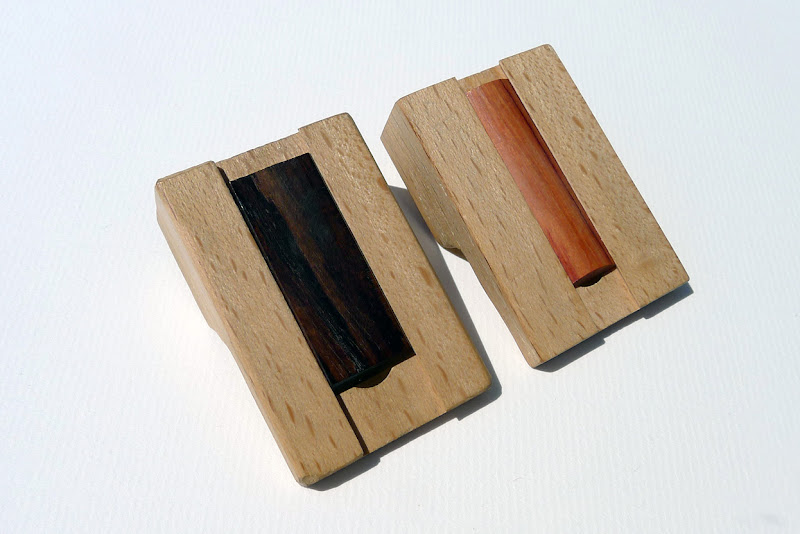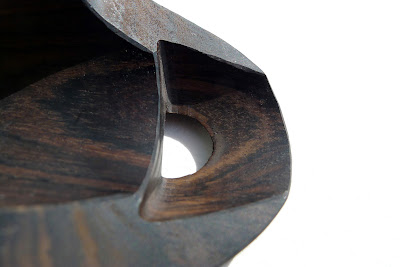As double-bass player, Mr. Degen felt the need to have a smaller instrument to carry with him all day long, and since he heard of nose flutes in 2008, he first got a wooden and a plastic one to look how they were done. He first made a try by modifying a recorder, and quickly decided to produce his own Nasenflöten.
Here is a research and test sample by Cornelius. As you can see, it is made of one piece of wood plus a translucent plastic slider, which allows to see the complete technical system... and much more.


 |  |
So, the nose flute by Cornelius Degen offers the ability to the whistler to "tune" his instrument. Do you want to play the Queen of the Night Aria ? Slide the tuner down and get a sharp instrument. Do you prefer to play a Bach's cello concerto ? Open the mouth window and get rich bass.
Now, how does it look on real finished flutes ?



The tuning slider is a piece of hard wood finely adjusted to the body groove by a sliding dovetail joint. With the exact balance between tightness (for the tuner to stay where you set it) and looseness (to allow another setting).
 |  |
Cornelius Degen loves to work with hard woods. He is a goldsmith too, and he uses the same tools for metal and wood. He is fond of rosewood and grenadilla (African blackwood) because of their stability.
I've got 2 beautiful nose flutes by Cornelius, both made in Grenadilla. One has a slider in rosewood, and the other (not yet totally finished) with a perpex tuner. Their shape is very original and very well designed. The idea was to make a nose flute as small as possible, yet comfortable. And it is a success, those flutes are very easy to play, and despite their geometric shape, quite ergonomical. For those, Cornelius had to develop and create a special tool for his milling machine, in order to mecanically shape the oval profile.

 |  |


 |  |
All the "technical parts" are milled or manufactured (Degen's flutes are 50% machined, 50% handmade) with a great precision, thanks to the ability and stability of the grenadilla. It is a pleasure to see the air duct, with its oblique plan, getting thinner and thinner, the more it reaches its exit. The labium is very very sharp and precisely done.

 |  |


 |  |
On the sound side, I must admit the Degen's flutes have reached my wooden flutes top 3. It is very precise, very confortable for me, and extremely powerful, thanks to its very hard wood. I could blast windows with its sharps, and I can set it for deep basses. I also found it so beautiful...
I'm not a good player enough to get and show all the possibilities of this instrument, but here is however a sound sample.


Boy oh boy, where was this blog when I wanted and needed it, 15 to 20 years ago?!
ReplyDeleteGreat to see yet another superb cratfsman going at it! I love the rose wood, as this was once actually advised to me by a church organ builder.
The problem of not being able to slide while having played a while could probably be avoided by having 2 or more identical 'sliders' prefixed.
The oval flute looks very similar to the grooved stone age whistle that top flute player Wil Offermans demonstrated to me in 1994: it is a stunning object which I love for its 'contained', monolithic look.
I believe that the perspex slide is a tremendous asset: I can imagine that the sound is enriched by the resonance coming from this material. I know for a fact that Piet Visser's Froby nose flute, which is totally made from perspex, has the finest reedy resonance I ever heard! It also has the easiest playability of any nose flute in my book!
Cornelius: when are we going to witness the very first gold nose flute? :-)
Well, dear Maikel, 20 years ago, I even didn't know I had a nose. This blog was even not in the limbos, and Cornelius Degen had to wait 16 years more himself to discover then make nose flutes :)
ReplyDeleteBy "2 or more sliders prefixed", you mean 2 or 3 flutes, I guess...
About your last question : Cornelius is one of the last civilized man, and has no computer and no internet. So, I'm not sure he will answer your question.
All the best
I think the adjustable windway is an interesting idea, and also practical. But, with my budget, it may be more convenient to buy several less expensive flutes with different characteristics.
ReplyDeleteI read somewhere about a recorder with adjustable windway, IIRC the roof could be raised or lowered,
It should also be possible to make a nose flute with sliding labium.
But I like the simplicity of the basic nose flute. Instead of making the instrument complicated, I would just get several.
That been said, this ones look great.
I am curious, which are the other in the top 3?.
Maybe you could publish a top 10 list.
Luis
Dear Luis,
DeleteThe other **wooden** flutes of my Top 3 are the ones by Heinrich Handler (Austria) and the ones by Takuma Ikeyama (Japan). Both were reviewed in this blog, here :
http://nose-flute.blogspot.fr/2011/10/review-heinrich-handlers-nose-flutes.html
and here :
http://nose-flute.blogspot.fr/2012/04/review-nose-flute-by-ise-association.html
The reason why I had several flutes adjusted and even built, was so that I could use them each for a different part of a song. I wanted to be able to switch sounds just like a guitar player. Obviously, with a multi-effects box this becomes far easier.
ReplyDeleteI have also become curious about Antoine's top 3 and I think that a top 10 would be a great thing to read about! If anybody has a collection to choose from, it must be this man! My personal top 3 soundwise would have to be my silver swan, Piet Visser's Froby and my green marbled swan, in that order. My original red and yellow swan has become too delicate to play, so he is on pension now.
The top ten or even top three personal choice of nose flutes is a nice idea - if the blog readers were not so reluctant about writing comments or contribute to the blog in whatever way (besides some helpful exceptions) it would be nice to ask nose flute players about their favorites. For me personally, number one is a clay bocarina, number two a unique ABS plastic violet and grey marbled bocarina (or, concerning playability and sound, the bocarina in general) and number three the Heinrich Handler wooden nose flute from Austria. Then there is a gap, a huge gap that I hope will be filled one day. Now we are waiting for the blogmaster's top 3,5, or ten.... Thanks, Maikel Mei, for your interesting comments and inspirations, the Nosy Diva
ReplyDeleteYou are more than welcome, Birte. I must say that this blog is really inspiring and I have said it before: I am most happy that it has been installed!
DeleteIndeed, it would be great to have more readers post their top 3 and leave behind their comments. I do believe this blog is the ideal medium for sharing.
Interesting to hear you are so into the Bocarina, which I believe is a superbly designed and wonderfully crafted object, or piece of art for that matter. The clay model really appeals to me, as I have always wanted to play one, yet couldn't find the right craftsman to do it. I also am a great fan of Miss Kanae's clay mask! I wish I could judge all those models out there myself. Who knows, one day...
(Nose Flute Day next year?)
Dear Nosy Diva, I wrote about my ***wooden*** top 3, excluding obviously the Bocarina.
DeleteAnyway, i'm not sure a "top something" is very pertinent : it's a matter of personal preferences...
Well, if you force me, I can tell you my "tops", but it has no real meaning, except for me, and more : I do not know (or tried) all of existing nose flutes!
ReplyDeleteBut for sure :
plastic : Bocarina (far away before the swan, itself far away before the Humanatone)
wood : already said : with no hierarchy : Ikeyama, Handler, Degen (then would come Max Zycha and some by Kunio Katada). I love the Wigert nose flute, but it's is a bit too difficult to play for me (need to be a very fine player for it...)
Metal : uh... sorry to say it, my aluminium Nasalette is my best and my hacked brass whistle too! (but I never tried silver nose flutes and so...). But my "Mellibrou" would immediately stand at the next position.
Clay : One of the Bocarina i own is my best, certainly. But the large Okan-Khamen is very good. And I wait for a top-quality one by Hiroaki Sasaki...
Bamboo : the flutes by Roi Bitton are quite good. And also the ones by Kunio Katada.
Merci beaucoup! Sorry for forcing you into confessing your nasal preferences - it is sure that this is very individual anyway and I am sure your words will not be misused for commercial purposes ....- but some readers of your blog are nosy people :))
DeleteFor the metal ones, I am sure that the aluminium model designed by you is pretty much on top!
I forgot to mention my preferred cardboard noseflute:
the one designed by a famous french artist, maybe you heard about this guy, he plays the ukulele also.
@Nosymusic : Thanks for your prefered cardboard nose flute. And which is your prefered potato one ? :)
ReplyDeleteThank you very much for your answer and comments.
ReplyDeleteI wish I had more nose flutes to compare and choose my top.
My commercial nose flutes are plastic. I have only tried bocarina and humanatone, and also have a hacked plastic whistle. Bocarina is by far the best, hacked whistle is a lot of fun, humanatone is good to give to the kids to play.
I have made some wooden nose flutes in various styles and sizes, some play better than others. My top tends to be my latest.
I have two in cardboard, they are fun too.
Talking about ceramics, my cousin is well known in the trade and spends much of his time in France, Unfortunately I have not seen him in years and don't know if he would be interested in making nose flutes. You can see him here:
http://www.ceramique-prometer.com/en/masterclass/15-gustavo-perez
Luis
Oh!! Your cousin id gifted and talented!! he ***SHOULD*** make nose flutes :)))
DeleteLuis, I love your cousin's work: the organic shapes, the feel, the 'fine lines', the texture, the colours.
DeleteIf anyone could do it, he must be the one! I have always felt that a ceramic flute would create the most wonderful sound.
I feel the bigger that ceramic flute is, the better it will be... I would be very interested to see your cousin create a nose flute in the very same style as his organic vases. I already picture myself with a nose flute resembling a 'sheng' with several 'wind chambers', and even a Le Corbusier's Notre Dame du Haut-style nose flute.
Call me crazy, but this is how inspired I get from the input on this blog! You might find it interesting to know that next week I am visiting a very gifted glassblower to see if we can create the first glass nose flute.
"I am visiting a very gifted glassblower to see if we can create the first glass nose flute."
DeleteWell... order 2 ! :)
Anybody else...?:-)
Delete